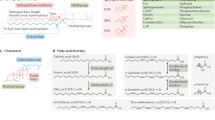Abstract
Biological membranes are composed largely of lipids and proteins. The most common arrangement of lipids in biological membranes is as a bilayer. This arrangement spontaneously forms a barrier for the passage of polar materials. The bilayer is thin but can have a large area in the dimension perpendicular to its thickness. The physical nature of the bilayer membrane will vary according to the conditions of the environment as well as the chemical structure of the lipid constituents of the bilayer. These physical properties determine the function of the membrane together with specific structural features of the lipids that allow them to have signaling properties.
The lipids of the membrane are not uniformly distributed. There is an intrinsic asymmetry between the two monolayers that constitute the bilayer. In addition, some lipids tend to be enriched in particular regions of the membrane, termed domains. There is evidence that certain domains recruit specific proteins into that domain. This has been suggested to be important for allowing interaction among different proteins involved in certain signal transduction pathways.
Membrane lipids have important roles in determining the physical properties of the membrane, in modulating the activity of membrane-bound proteins and in certain cases being specific secondary messengers that can interact with specific proteins. A large variety of lipids present in biological membranes result in them possessing many functions.
Access this chapter
Tax calculation will be finalised at checkout
Purchases are for personal use only
Similar content being viewed by others
References
Myers DS, Ivanova PT, Milne SB, Brown HA (2011) Quantitative analysis of glycerophospholipids by LC-MS: acquisition, data handling, and interpretation. Biochim Biophys Acta 1811:748–757
D’Souza K, Epand RM (2014) Enrichment of phosphatidylinositols with specific acyl chains. Biochim Biophys Acta 1838(6):1501–1508
Patil VA, Greenberg ML (2013) Cardiolipin-mediated cellular signaling. Adv Exp Med Biol 991:195–213
Schlame M, Ren M, Xu Y, Greenberg ML, Haller I (2005) Molecular symmetry in mitochondrial cardiolipins. Chem Phys Lipids 138:38–49
Steck TL, Lange Y (2010) Cell cholesterol homeostasis: mediation by active cholesterol. Trends Cell Biol 20:680–687
Bloom M, Evans E, Mouritsen OG (1991) Physical properties of the fluid lipid-bilayer component of cell membranes: a perspective. Q Rev Biophys 24:293–397
Siegel DP (2008) The Gaussian curvature elastic energy of intermediates in membrane fusion. Biophys J 95:5200–5215
Frisz JF, Klitzing HA, Lou K, Hutcheon ID, Weber PK, Zimmerberg J, Kraft ML (2013) Sphingolipid domains in the plasma membranes of fibroblasts are not enriched with cholesterol. J Biol Chem 288:16855–16861
Lozano MM, Liu Z, Sunnick E, Janshoff A, Kumar K, Boxer SG (2013) Colocalization of the ganglioside G(M1) and cholesterol detected by secondary ion mass spectrometry. J Am Chem Soc 135:5620–5630
Lichtenberg D, Goni FM, Heerklotz H (2005) Detergent-resistant membranes should not be identified with membrane rafts. Trends Biochem Sci 30:430–436
Kwik J, Boyle S, Fooksman D, Margolis L, Sheetz MP, Edidin M (2003) Membrane cholesterol, lateral mobility, and the phosphatidylinositol 4,5-bisphosphate-dependent organization of cell actin. Proc Natl Acad Sci U S A 100:13964–13969
Author information
Authors and Affiliations
Corresponding author
Editor information
Editors and Affiliations
Rights and permissions
Copyright information
© 2015 Springer Science+Business Media New York
About this protocol
Cite this protocol
Epand, R.M. (2015). Introduction to Membrane Lipids. In: Owen, D. (eds) Methods in Membrane Lipids. Methods in Molecular Biology, vol 1232. Humana Press, New York, NY. https://doi.org/10.1007/978-1-4939-1752-5_1
Download citation
DOI: https://doi.org/10.1007/978-1-4939-1752-5_1
Published:
Publisher Name: Humana Press, New York, NY
Print ISBN: 978-1-4939-1751-8
Online ISBN: 978-1-4939-1752-5
eBook Packages: Springer Protocols




